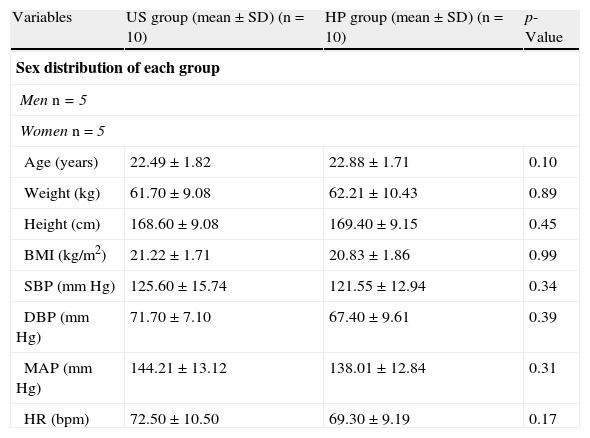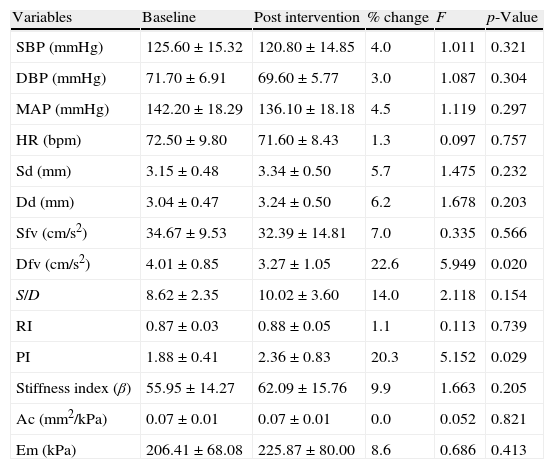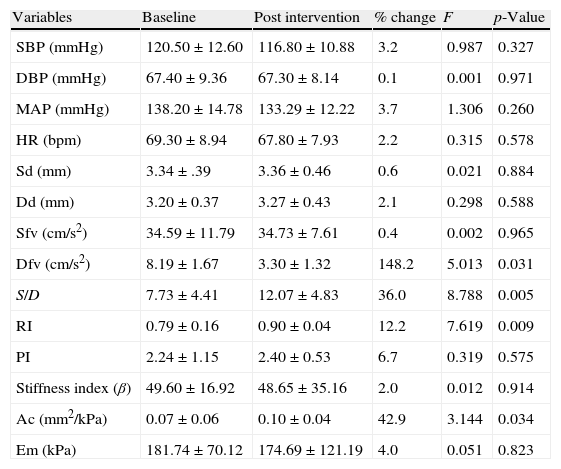Recently, non-pharmacological resources to relieve pain like hot packs and ultrasound (US) have become common in clinical practice. However, little experimental evidence is available about the possible mechanisms through which these methods bring about pain relief. We aimed to determine the effects of hot packs and US on the acute vascular response and on hemodynamic parameters in healthy subjects.
Materials and methodsWe conducted an experimental study in 20 healthy subjects (10 men and 10 women; mean age, 22.54±1.70 years). The two interventions were randomly applied: (a) hot packs (n=10): 15min at 60°C and (b) US (n=10): 15min at 1MHz. Before and after each intervention, the following vascular parameters were measured in the brachial artery using Doppler ultrasonography with a 7MHz probe: arterial compliance, elastic modulus, beta stiffness index, systolic and diastolic arterial diameters, systolic flow velocity and diastolic flow velocity, systolic/diastolic ratio, resistance index, and pulsatility index. The following hemodynamic parameters were monitored: heart rate and blood pressure (systolic, diastolic, and mean).
ResultsAfter the application of hot packs, we observed changes in diastolic flow velocity and in the pulsatility index (p<05). After the application of US, we observed changes in diastolic flow velocity, systolic/diastolic ratio, resistance index, and arterial compliance (p<05). No changes in hemodynamic parameters were observed after either intervention.
ConclusionsApplying hot packs or US modifies the physiology of the vascular system but does not affect hemodynamic parameters in healthy subjects.
Recientemente determinados recursos no farmacológicos, como el paquete caliente (PC) y los ultrasonidos (US), son utilizados en el alivio del dolor con alto grado de aceptación en la práctica clínica. Sin embargo, la evidencia experimental que apoye los posibles mecanismos por los que se producen estos beneficios es escasa. El objetivo de este estudio fue comprobar los efectos de dos métodos de termoterapia (PC y US) sobre la respuesta vascular aguda y parámetros hemodinámicos en sujetos sanos.
Materiales y métodosEstudio experimental en 20 sujetos sanos (10 hombres y 10 mujeres; edad media, 22,54±1,70 años). Se aplicaron dos intervenciones de forma aleatoria: a) PC (n=10): 15min a 60°C, y b) US (n=10): 15min a 1Mhz, y se realizaron mediciones vasculares mediante ecografía doppler con transductor de 7Mhz, antes y después de cada intervención. Parámetros vasculares: distensibilidad arterial (Da), módulo elástico (Ep), índice beta de rigidez (β), diámetro arterial sistólico y diastólico, velocidad del flujo sistólico (Vfs) y diastólico (Vfd), relación sístole/diástole (RSD), índice de resistencia (IR) e índice de pulsatilidad (IP) en la arteria braquial, y monitorización hemodinámica de la frecuencia cardiaca y de las presiones arteriales sistólica, diastólica y media.
ResultadosSe encontraron diferencias en la Vfd y en el IP (p<0,05), en la intervención con PC, mientras que la intervención con US mostró cambios en la Vfd, la RSD, el IR y la Da (p<0,05). No se encontraron cambios en los parámetros hemodinámicos.
ConclusionesLa fisiología del sistema vascular se modifica por la aplicación del PC y los US, sin afectar los parámetros hemodinámicos en sujetos sanos.











